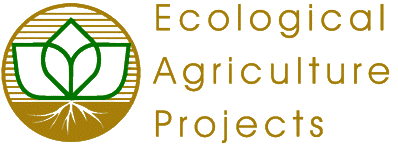

EAP Publications | Virtual Library | Magazine Rack | Search
Join the Ecological Solutions RoundtableEAP Publication - 32
S. B. Hill.
Department of Entomology, Macdonald College of McGill University Ste-Anne de Bellevue, Quebec H9X lC0 Canada
Today, pests are usually seen as enemies and pest control as the use of science and technology to impress them. While "rest successes have been achieved by following this approach, there have also been numerous disbenefits including damage to human health. to non-target species including beneficial organisms, and the development of additional pest problems. Recognition of this situation has led to the development of integrated pest management (IPM), an approach designed to retain the benefits of the previous methods of control and to miasma the disbenefits. Although progress has been made in this direction there remain inherent problems, particularly because of the continued dependence of IPM on curative solutions. The alternative approach is to develop preventative solutions. Whereas curative approaches tend to be generated within disciplines, preventative solutions are transdisciplinary and involve the redesign of whole systems.
To understand this clearly I believe it is necessary to take an evolutionary approach towards the development of pest control Indeed, the nature of the relationship between people and pests may be seen as an indicator of the level we have reached in the evolution of our own species. In this paper I will develop this argument and share with you the way on winch my approach towards pest control has changed over the past ten years.
Pests comprise competitors of humans for resources, enemies, including those that transmit diseases, and nuisance organisms.
The pest status of competitors is usually defined in terms of economics. Thus, they an considered to be insists when it is economic to control them. This may reflect both rational and irrational criteria, such as cosmetic standards for the appearance of food Enemies and nuisance organisms may also be controlled in response to both rational and irrational criteria. Weed free lawns and insect free recreational areas exemplify the latter. As such definitions reflect our values, it is likely that by developing more rational values we will also generate a more rational definition of pests, and more rational approaches to their control or prevention. For example, by defining pests as indicator organisms of maldesigned and malfunctioning ecosystems, in our response to them we would be more likely to focus our attention on redesign and improved management than or. the enemy, the pest, and its elimination or control.
Moore (1967) has divided our past relationships with potential crop pests into four stages (Fig. 1) pre-agriculture , when pests rarely caused significant damage because of the ecosystems' natural complexly; pre-pesticide agriculture, when, with the simplification of ecosystems, pests followed cycles of outbreak and repression by natural controls; pesticide agriculture, when pesticide use was followed by pest resurgence and the development of secondary pests as a result of the repression of natural controls; and pesticide resistance agriculture, when pesticides became less effective because of their selection of resistant individuals within pest populations.
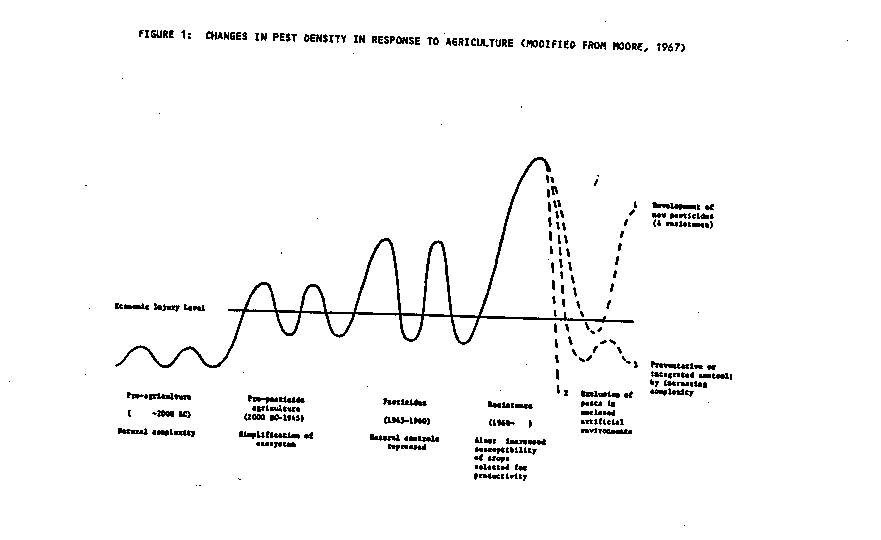
With suspect to the future, Moore argues that we have three alternatives continue to develop new pesticides (and therefore also new resistance); grow crops in enclosed artificial environment designed to exclude pests; and redesign agroecosystems to incorporate enough characteristics of pre-agriculture ecosystems to keep pests population densities below economic thresholds.
My own perception is somewhat similar to Moore's and is show in Fig 2. It describes what has happened and what I hope will happen in the future. Thus, the major development that is still taking place is an evolution from a control to a management philosophy, and from reliance on one or a few pest control strategies to the integration of many approaches into a system usually referred to as integrated pest management or IPM. At the present time efforts to introduce alternatives may be conveniently grouped into three approaches: "efficiency , substitution", and 'redesign . Integrated pest management (IPM) combines techniques that largely fall within the first two approaches together with on use of pesticide. IPM's first requirement is access to accurate techniques for monitoring pests (and ideally, also their natural controls). Monitoring techniques include routine examination of the crop and the crop environment, simply methods such as 'jarring', sweeping with a net, interception traps, and traps that incorporate attractants, such as pheromones or sex attractants. These latter are also sometimes used as control measures, particularly to disrupt the normal mating behaviour of certain pests. Other ways to increase the "efficiency" with which pesticides used include better formulation and methods of application (e.g. electrostatic applicators), and access to economic threshold data for each of the pests. The requirement for pesticides can also be reduced by using resistant crop varieties, and by trapping the pests.
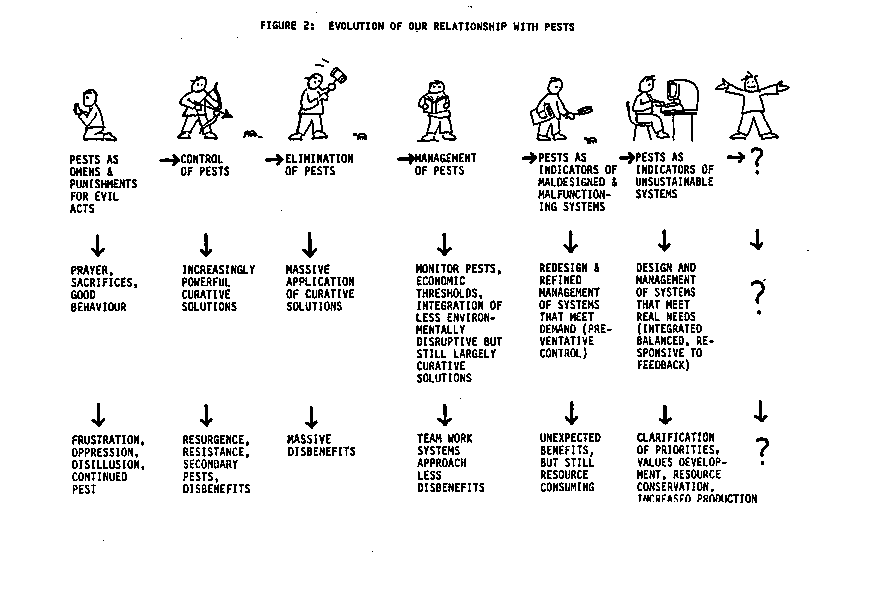
The substitution" approach involves the replacement of highly toxic, persistent, nonspecific pesticides with less harmful products or, more preferably, with biological controls (parasites, predators, and pathogens of the pests). Parasites include parasitic wasps, and certain flies and nematodes. Examples of predators are ladybird, ground and rove beetles, lacewing larvae, certain wasps, flies, spiders and their relatives, birds, and many others. Pathogens include bacteria, fungi, viruses, and protozoa.
Flooding pest populations with sterile or genetically incompatible males has proved effective for controlling certain pest species, particularly for isolated populations. Efforts to find more specific and safer pesticides has led to the investigation of new botanical pesticides, hormones, sterilants and contraceptives, and also the re-examination of abrasive and sorbative dusts, such as Diatomaceous earth, particularly for insects in stored grain and in buildings.
Alternatives mentioned up to this point, although potentially superior to non-specific toxic chemicals, share one important flaw with the latter. As they are primarily used in a curative way (see upper part of Fig. 3), the more effective they are, the more they will protect and perpetuate those features of the agricultural system that are the underlying cause' of pest problems (Fig. 4). Because of this, I regard them as "shallow" ecological approaches. They are external solutions to internal problems.
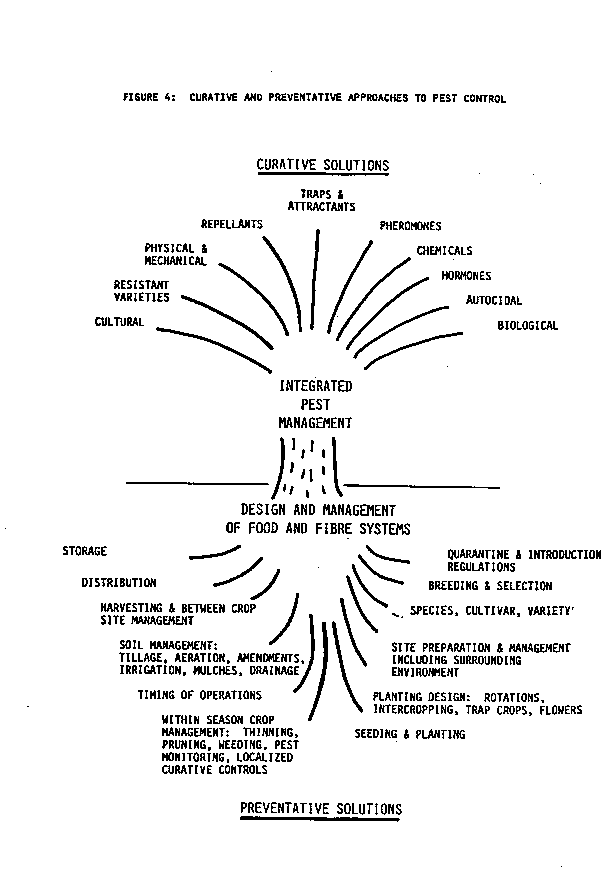
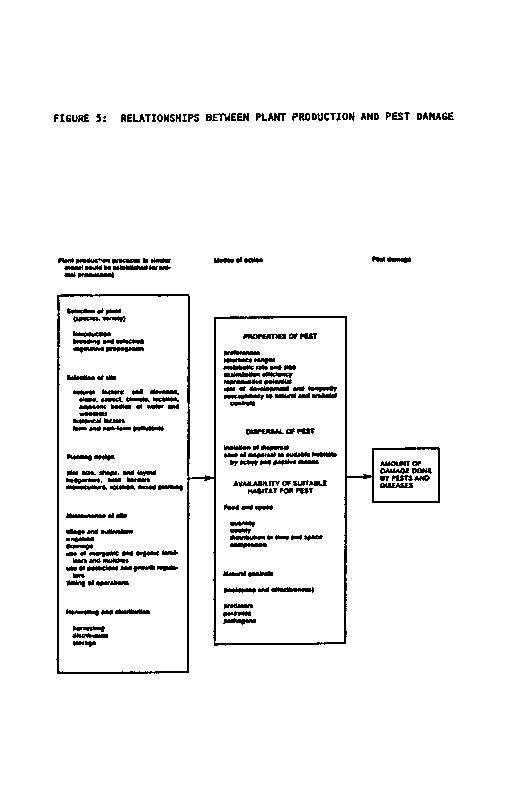
The main advantage of IPM is that it has made the practice of pest control more' "scientific" and more precise. In its refined form, it is based on a systems approach and is. administered by a team of specialists from a diversity of disciplines. It has been particularly, helpful in answering the following five questions: Is control warranted, when should it be applied, where should controls be applied, what mix of controls are appropriate, and how successful was the intervention? In addition, although it claims to be integrated, IPM still tends to take a linear approach, and it fails to deal with the extremely complex interrelationship between influencing variables. Another view of IPM is that it larger, represents an effort to use pesticides more efficiently and, where economic, substitute less environmentally disruptive approaches, such as biological controls.
It is apparent then that all IPM programs are severely limited by the designs ant management strategies of present food and fibre production systems, particularly their ' uniformity, reliance on susceptive crop varieties, and tendency to cause stress to crops during the growing process, thus making them more attractive to pests and susceptive to damage.
If IPM is limited in its development, as I believe it is, then it is necessary to take a different approach before agriculture can become "sustainable". Such an approach was implied in the discussion of the definition of pest above (see also Fig. 2). Thus, if pests are viewed as indicators of maldesigned and malfunctioning systems, the requirement is to understand the causes of pest outbreaks and to modify the design and management of systems to prevent them.
In plant production the causes of pest outbreaks are associated with the main stages of production (left hand side of Fig. 4): plan selection, site selection and preparation, planting design, site maintenance, harvesting, distribution, storage and the timing of all operations.
Just as these practices are responsible for pest damage; by influencing the properties of pests, their dispersal, availability of suitable food and space and by limiting the presence and effectiveness of natural controls (central part of Fig. 4), it is by the integration of changes in these practices that effective preventative methods of pest control are likely to be found (see also lower part of Fig. 3).
These "deep" ecological solutions comprise the components of the "redesign" approach -the only approach that I advocate for the future. This is because it incorporates the kind of value change referred to earlier, it pictures humans within, rather than on the outside, of the food system; and it seeks to solve problems internally by accommodating and supporting the system's natural homeostatic processes, rather than relying on the repeated application of increasingly ineffective cures to inappropriately designed, malfunctioning systems.
The roots of this "redesign" strategy are to be found in "cultural" methods of pest control (Table I). Cultural controls are the oldest methods that have been used to manage pest populations, and because they are preventative rather than curative they are dependent on long-range planning. They also depend on a detailed knowledge of the big-ecology of the natural control agents and their environment. These relationships were poorly understood in the past, the results of cultural control were very variable, and it was often difficult to evaluate their effectiveness. It is understandable that most farmers were eventually won over to the, at first, more reliable and less knowledge- and skill-dependent toxic chemical solutions to pest problems.
Today the situation is very different from those early days of pest control. We have a much better understanding of the big-ecological relationships within crop systems and predictive computer models are available for some pests.
For this approach to be successful the barriers to the development and implementation of cultural methods of pest control (and their integration with other agricultural goals and practices) must be identified. Foremost among these are the lack of appropriate research, training, services, equipment, and crop species and cultivars. In addition to responding to these deficiencies, changes in human values and attitudes will also be requited a shift in emphasis from cosmetic to nutritional quality; and from pest elimination to management below thresholds related to our values.
The development of "deep" ecological approaches require us to start to identify the driving and restraining forces that are operating, and to work towards strengthening the former and weakening the latter. On a personal level this transformational process involves developing a sense of integration with the earth, and paying attention to the processes of balance and feedback. It involves studying how natural systems function, spending time with them and learning how to imitate them. The development of this approach win not only affect the future of pest control but, more importantly, the evolution of our species; and by supporting such developments it is likely that the "deep" approach advocated here win, in their rum, become the "shallow" approach of some future generation.
Moore, N. 1967. A synopsis of the pesticide problem. Advances in Ecological Research, 4: 75-129.
Copyright © 1990 Ecological Agriculture Projects
Info Request | Services | Become EAP Member | Site Map
Give us your comments about the EAP site
Ecological Agriculture Projects, McGill University (Macdonald
Campus)
Ste-Anne-de-Bellevue, QC, H9X 3V9 Canada
Telephone:
(514)-398-7771
Fax:
(514)-398-7621
Email: eapinfo@macdonald.mcgill.ca
To report problems or otherwise comment on the structure of this site, send mail to the Webmaster